Roberts A.D. The Cambridge History of Africa, Volume 7: from 1905 to 1940
Подождите немного. Документ загружается.

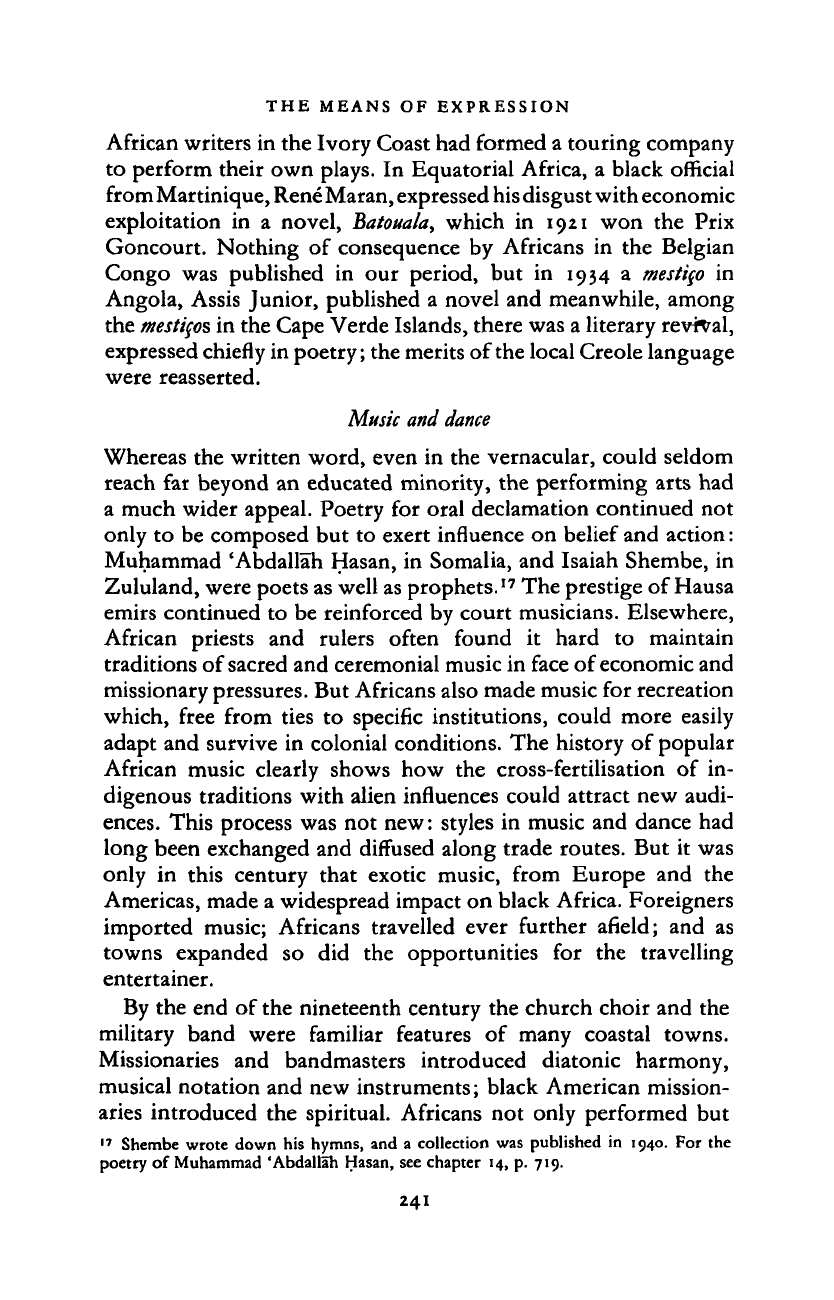
THE MEANS OF EXPRESSION
African writers in the Ivory Coast had formed
a
touring company
to perform their own plays.
In
Equatorial Africa,
a
black official
from Martinique, Rene Maran, expressed his disgust with economic
exploitation
in a
novel,
Batouala,
which
in 1921 won the
Prix
Goncourt. Nothing
of
consequence
by
Africans
in the
Belgian
Congo
was
published
in our
period,
but in 1934 a
mestizo
in
Angola, Assis Junior, published
a
novel
and
meanwhile, among
the
mestizos
in
the Cape Verde Islands, there was a literary revival,
expressed chiefly in poetry; the merits of the local Creole language
were reasserted.
Music and dance
Whereas
the
written word, even
in the
vernacular, could seldom
reach
far
beyond
an
educated minority,
the
performing arts
had
a much wider appeal. Poetry
for
oral declamation continued
not
only
to be
composed
but to
exert influence
on
belief and action:
Muhammad 'Abdallah Hasan,
in
Somalia,
and
Isaiah Shembe,
in
Zululand, were poets as well as prophets.
17
The prestige
of
Hausa
emirs continued
to be
reinforced
by
court musicians. Elsewhere,
African priests
and
rulers often found
it
hard
to
maintain
traditions
of
sacred and ceremonial music in face of economic and
missionary pressures. But Africans also made music
for
recreation
which, free from ties
to
specific institutions, could more easily
adapt
and
survive
in
colonial conditions. The history
of
popular
African music clearly shows
how the
cross-fertilisation
of in-
digenous traditions with alien influences could attract
new
audi-
ences.
This process
was not
new: styles
in
music
and
dance
had
long been exchanged
and
diffused along trade routes.
But it was
only
in
this century that exotic music, from Europe
and the
Americas, made
a
widespread impact
on
black Africa. Foreigners
imported music; Africans travelled ever further afield;
and as
towns expanded
so did the
opportunities
for the
travelling
entertainer.
By
the end of
the nineteenth century
the
church choir
and the
military band were familiar features
of
many coastal towns.
Missionaries
and
bandmasters introduced diatonic harmony,
musical notation
and
new instruments; black American mission-
aries introduced
the
spiritual. Africans
not
only performed
but
17
Shembe wrote down
his
hymns,
and a
collection
was
published
in
1940.
For the
poetry
of
Muhammad 'Abdallah Hasan,
see
chapter 14,
p. 719.
241
Cambridge Histories Online © Cambridge University Press, 2008
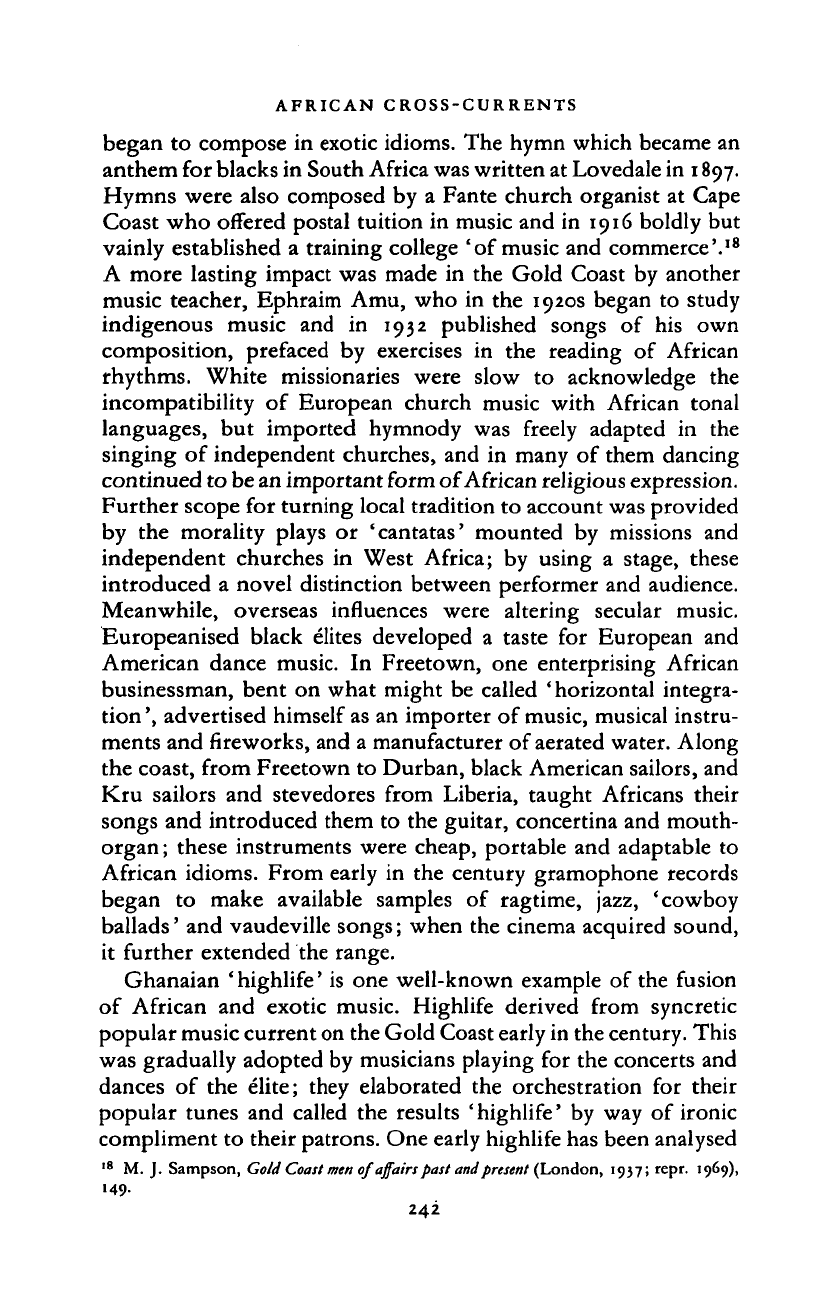
AFRICAN CROSS-CURRENTS
began
to
compose
in
exotic idioms. The hymn which became an
anthem for blacks in South Africa was written at Lovedale in 1897.
Hymns were also composed
by a
Fante church organist
at
Cape
Coast who offered postal tuition
in
music and
in
1916 boldly but
vainly established
a
training college
'of
music and commerce'.
18
A more lasting impact was made
in the
Gold Coast
by
another
music teacher, Ephraim Amu, who
in the
1920s began
to
study
indigenous music
and in 1932
published songs
of his own
composition, prefaced
by
exercises
in the
reading
of
African
rhythms. White missionaries were slow
to
acknowledge
the
incompatibility
of
European church music with African tonal
languages,
but
imported hymnody
was
freely adapted
in the
singing
of
independent churches,
and in
many
of
them dancing
continued to be an important form of African religious expression.
Further scope for turning local tradition to account was provided
by
the
morality plays
or
'cantatas' mounted
by
missions
and
independent churches
in
West Africa;
by
using
a
stage, these
introduced
a
novel distinction between performer and audience.
Meanwhile, overseas influences were altering secular music.
Europeanised black elites developed
a
taste
for
European
and
American dance music.
In
Freetown,
one
enterprising African
businessman, bent
on
what might
be
called 'horizontal integra-
tion', advertised himself as an importer
of
music, musical instru-
ments and fireworks, and
a
manufacturer of aerated water. Along
the coast, from Freetown to Durban, black American sailors, and
Kru sailors
and
stevedores from Liberia, taught Africans their
songs and introduced them
to
the guitar, concertina and mouth-
organ; these instruments were cheap, portable and adaptable
to
African idioms. From early
in the
century gramophone records
began
to
make available samples
of
ragtime, jazz, 'cowboy
ballads' and vaudeville songs; when the cinema acquired sound,
it further extended the range.
Ghanaian 'highlife'
is
one well-known example
of
the fusion
of African
and
exotic music. Highlife derived from syncretic
popular music current on the Gold Coast early in the century. This
was gradually adopted by musicians playing
for
the concerts and
dances
of the
elite; they elaborated
the
orchestration
for
their
popular tunes
and
called
the
results 'highlife'
by
way
of
ironic
compliment to their patrons. One early highlife has been analysed
18
M.
J.
Sampson, GoldCoast
men
ofaffairs past and
present
(London, 1937; repr. 1969),
149.
242
Cambridge Histories Online © Cambridge University Press, 2008
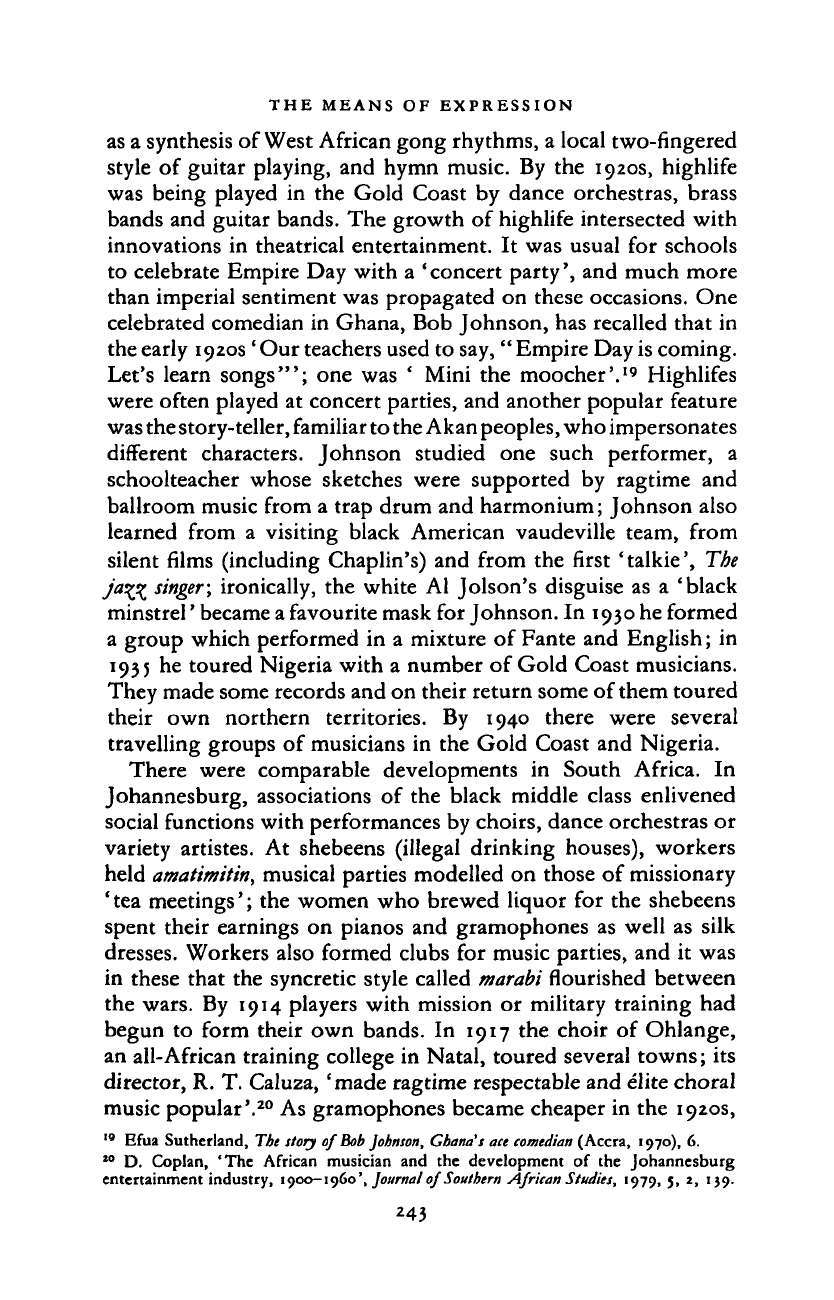
THE MEANS OF EXPRESSION
as a synthesis of West African gong rhythms, a local two-fingered
style of guitar playing, and hymn music. By the 1920s, highlife
was being played
in
the Gold Coast by dance orchestras, brass
bands and guitar bands. The growth of highlife intersected with
innovations in theatrical entertainment.
It
was usual for schools
to celebrate Empire Day with a 'concert party', and much more
than imperial sentiment was propagated on these occasions. One
celebrated comedian in Ghana, Bob Johnson, has recalled that in
the early 1920s
'
Our teachers used to say, " Empire Day is coming.
Let's learn songs'"; one was
'
Mini the moocher'.
19
Highlifes
were often played at concert parties, and another popular feature
was the story-teller, familiar to the Akan
peoples,
who impersonates
different characters. Johnson studied
one
such performer,
a
schoolteacher whose sketches were supported
by
ragtime and
ballroom music from a trap drum and harmonium; Johnson also
learned from
a
visiting black American vaudeville team, from
silent films (including Chaplin's) and from the first 'talkie', The
ja%%
singer;
ironically, the white Al Jolson's disguise as
a
'black
minstrel' became a favourite mask for Johnson. In 1930 he formed
a group which performed in
a
mixture of Fante and English;
in
1935 he toured Nigeria with a number of Gold Coast musicians.
They made some records and on their return some of them toured
their
own
northern territories.
By
1940 there were several
travelling groups of musicians in the Gold Coast and Nigeria.
There were comparable developments
in
South Africa.
In
Johannesburg, associations
of
the black middle class enlivened
social functions with performances by choirs, dance orchestras or
variety artistes.
At
shebeens (illegal drinking houses), workers
held
amatimitin,
musical parties modelled on those of missionary
'tea meetings'; the women who brewed liquor for the shebeens
spent their earnings on pianos and gramophones as well as silk
dresses. Workers also formed clubs for music parties, and
it
was
in these that the syncretic style called
marabi
flourished between
the wars. By 1914 players with mission
or
military training had
begun
to
form their own bands.
In
1917 the choir
of
Ohlange,
an all-African training college in Natal, toured several towns; its
director, R. T. Caluza, ' made ragtime respectable and elite choral
music popular'.
20
As gramophones became cheaper in the 1920s,
19
Efua Sutherland, The story of
Bob
Johnson,
Ghana's
ace comedian
(Accra, 1970),
6.
10
D.
Coplan, 'The African musician
and the
development
of the
Johannesburg
entertainment industry, 1900-i960'',
Journal
ojSouthern African Studies, 1979,
5, 2,
i}9.
243
Cambridge Histories Online © Cambridge University Press, 2008
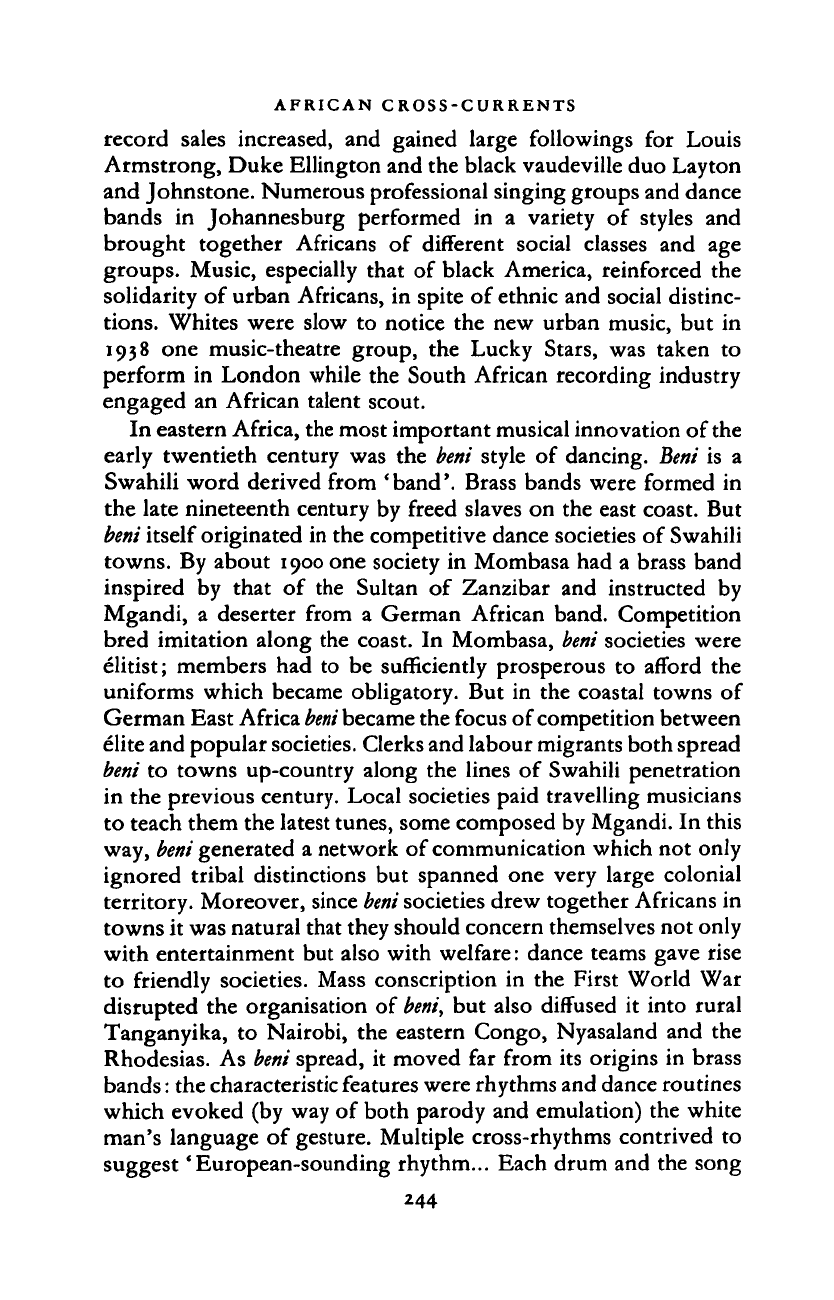
AFRICAN CROSS-CURRENTS
record sales increased, and gained large followings for Louis
Armstrong, Duke Ellington and the black vaudeville duo Layton
and Johnstone. Numerous professional singing groups and dance
bands in Johannesburg performed in a variety of styles and
brought together Africans of different social classes and age
groups. Music, especially that of black America, reinforced the
solidarity of urban Africans, in spite of ethnic and social distinc-
tions.
Whites were slow to notice the new urban music, but in
1938 one music-theatre group, the Lucky Stars, was taken to
perform in London while the South African recording industry
engaged an African talent scout.
In eastern Africa, the most important musical innovation of the
early twentieth century was the
bent
style of dancing. Beni is a
Swahili word derived from 'band'. Brass bands were formed in
the late nineteenth century by freed slaves on the east coast. But
bent
itself originated in the competitive dance societies of Swahili
towns. By about 1900 one society in Mombasa had a brass band
inspired by that of the Sultan of Zanzibar and instructed by
Mgandi, a deserter from a German African band. Competition
bred imitation along the coast. In Mombasa,
bent
societies were
elitist; members had to be sufficiently prosperous to afford the
uniforms which became obligatory. But in the coastal towns of
German East Africa
bent
became the focus of competition between
elite and popular
societies.
Clerks and labour migrants both spread
bent
to towns up-country along the lines of Swahili penetration
in the previous century. Local societies paid travelling musicians
to teach them the latest tunes, some composed by Mgandi. In this
way,
bent
generated a network of communication which not only
ignored tribal distinctions but spanned one very large colonial
territory. Moreover, since
bent
societies drew together Africans in
towns it was natural that they should concern themselves not only
with entertainment but also with welfare: dance teams gave rise
to friendly societies. Mass conscription in the First World War
disrupted the organisation of
bent,
but also diffused it into rural
Tanganyika, to Nairobi, the eastern Congo, Nyasaland and the
Rhodesias. As
bent
spread, it moved far from its origins in brass
bands:
the characteristic features were rhythms and dance routines
which evoked (by way of both parody and emulation) the white
man's language of gesture. Multiple cross-rhythms contrived to
suggest 'European-sounding rhythm... Each drum and the song
244
Cambridge Histories Online © Cambridge University Press, 2008
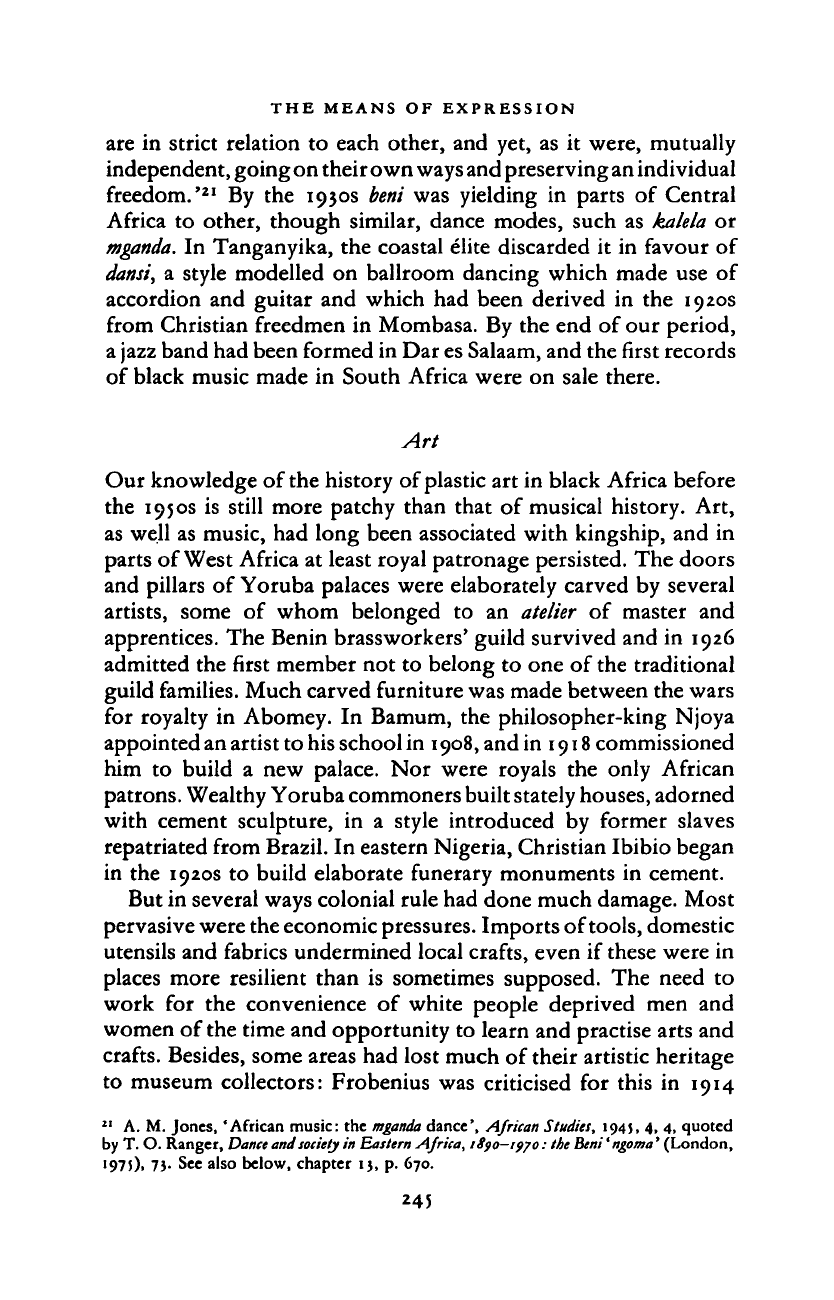
THE MEANS OF EXPRESSION
are in strict relation
to
each other, and yet, as
it
were, mutually
independent, going on their own
ways
and preserving an individual
freedom.'
21
By the 1930s
bent
was yielding
in
parts
of
Central
Africa
to
other, though similar, dance modes, such as kalela
or
mganda.
In Tanganyika, the coastal elite discarded
it
in favour of
dansi,
a.
style modelled on ballroom dancing which made use of
accordion and guitar and which had been derived
in
the 1920s
from Christian freedmen in Mombasa. By the end of our period,
a jazz band had been formed in Dar es Salaam, and the first records
of black music made in South Africa were on sale there.
Art
Our knowledge of the history of plastic art in black Africa before
the 1950s
is
still more patchy than that of musical history. Art,
as well as music, had long been associated with kingship, and in
parts of West Africa at least royal patronage persisted. The doors
and pillars of Yoruba palaces were elaborately carved by several
artists, some
of
whom belonged
to an
atelier
of
master
and
apprentices. The Benin brassworkers' guild survived and in 1926
admitted the first member not to belong to one of the traditional
guild families. Much carved furniture was made between the wars
for royalty in Abomey.
In
Bamum, the philosopher-king Njoya
appointed an artist to his school in
1908,
and in
1918
commissioned
him
to
build
a
new palace. Nor were royals the only African
patrons. Wealthy Yoruba commoners built stately
houses,
adorned
with cement sculpture,
in a
style introduced
by
former slaves
repatriated from Brazil. In eastern Nigeria, Christian Ibibio began
in the 1920s to build elaborate funerary monuments in cement.
But in several ways colonial rule had done much damage. Most
pervasive were the economic
pressures.
Imports of
tools,
domestic
utensils and fabrics undermined local crafts, even if these were in
places more resilient than
is
sometimes supposed. The need
to
work
for
the convenience
of
white people deprived men and
women of the time and opportunity to learn and practise arts and
crafts.
Besides, some areas had lost much of their artistic heritage
to museum collectors: Frobenius was criticised for this
in
1914
21
A.
M. Jones, 'African music: the
mganda
dance', African Studies, 1945,
4,
4, quoted
by T. O. Ranger,
Dance
and
society
in Eastern Africa, tif0-1970: the Beni'
ngoma'
(London,
197;),
73. See also below, chapter 13, p. 670.
245
Cambridge Histories Online © Cambridge University Press, 2008
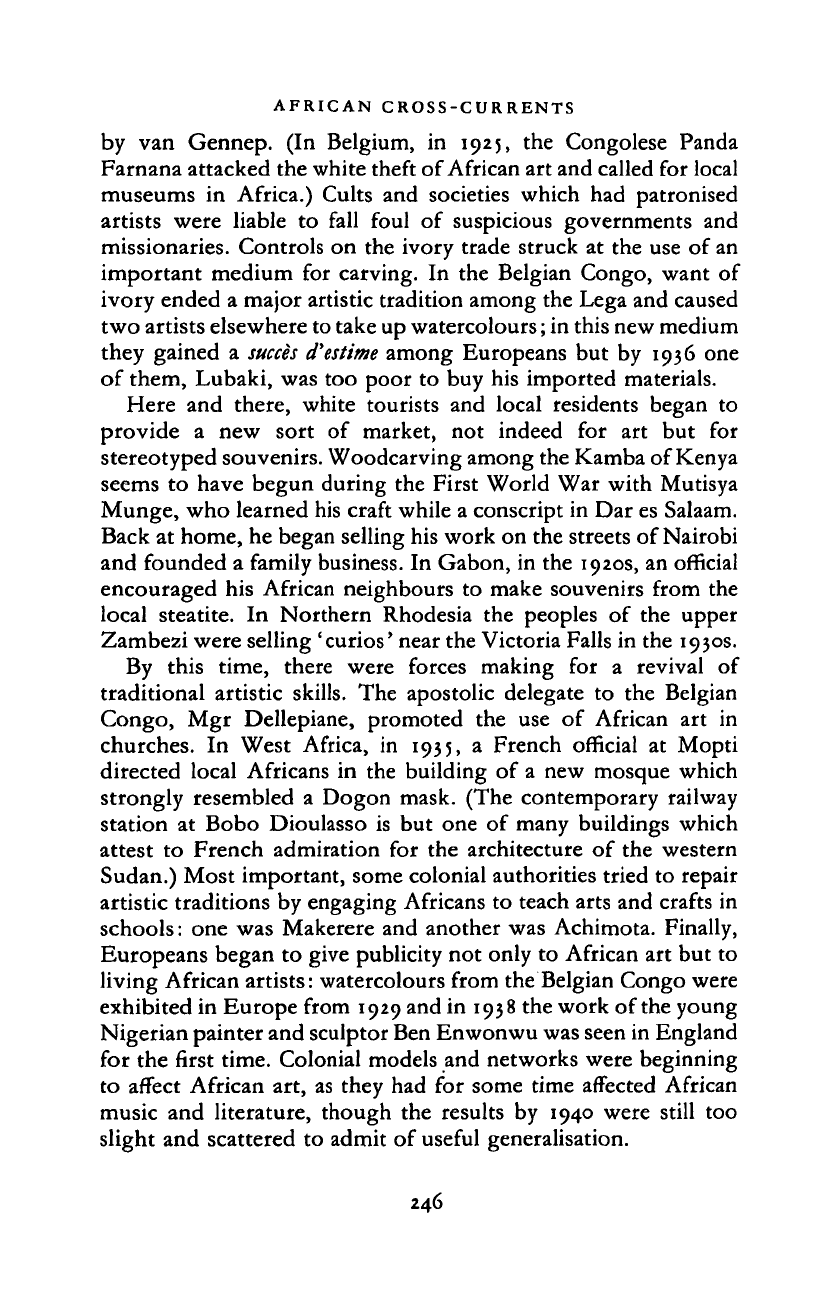
AFRICAN CROSS-CURRENTS
by van Gennep. (In Belgium, in 1925, the Congolese Panda
Farnana attacked the white theft of African art and called for local
museums in Africa.) Cults and societies which had patronised
artists were liable to fall foul of suspicious governments and
missionaries. Controls on the ivory trade struck at the use of an
important medium for carving. In the Belgian Congo, want of
ivory ended a major artistic tradition among the Lega and caused
two artists elsewhere to take up watercolours; in this new medium
they gained a
succes
d'estime
among Europeans but by 1936 one
of them, Lubaki, was too poor to buy his imported materials.
Here and there, white tourists and local residents began to
provide a new sort of market, not indeed for art but for
stereotyped souvenirs. Woodcarving among the Kamba of Kenya
seems to have begun during the First World War with Mutisya
Munge, who learned his craft while a conscript in Dar es Salaam.
Back at home, he began selling his work on the streets of Nairobi
and founded a family business. In Gabon, in the 1920s, an official
encouraged his African neighbours to make souvenirs from the
local steatite. In Northern Rhodesia the peoples of the upper
Zambezi were selling 'curios' near the Victoria Falls in the 1930s.
By this time, there were forces making for a revival of
traditional artistic skills. The apostolic delegate to the Belgian
Congo, Mgr Dellepiane, promoted the use of African art in
churches. In West Africa, in 1935, a French official at Mopti
directed local Africans in the building of a new mosque which
strongly resembled a Dogon mask. (The contemporary railway
station at Bobo Dioulasso is but one of many buildings which
attest to French admiration for the architecture of the western
Sudan.) Most important, some colonial authorities tried to repair
artistic traditions by engaging Africans to teach arts and crafts in
schools: one was Makerere and another was Achimota. Finally,
Europeans began to give publicity not only to African art but to
living African artists: watercolours from the Belgian Congo were
exhibited in Europe from 1929 and in 1938 the work of the young
Nigerian painter and sculptor Ben Enwonwu was seen in England
for the first time. Colonial models and networks were beginning
to affect African art, as they had for some time affected African
music and literature, though the results by 1940 were still too
slight and scattered to admit of useful generalisation.
246
Cambridge Histories Online © Cambridge University Press, 2008
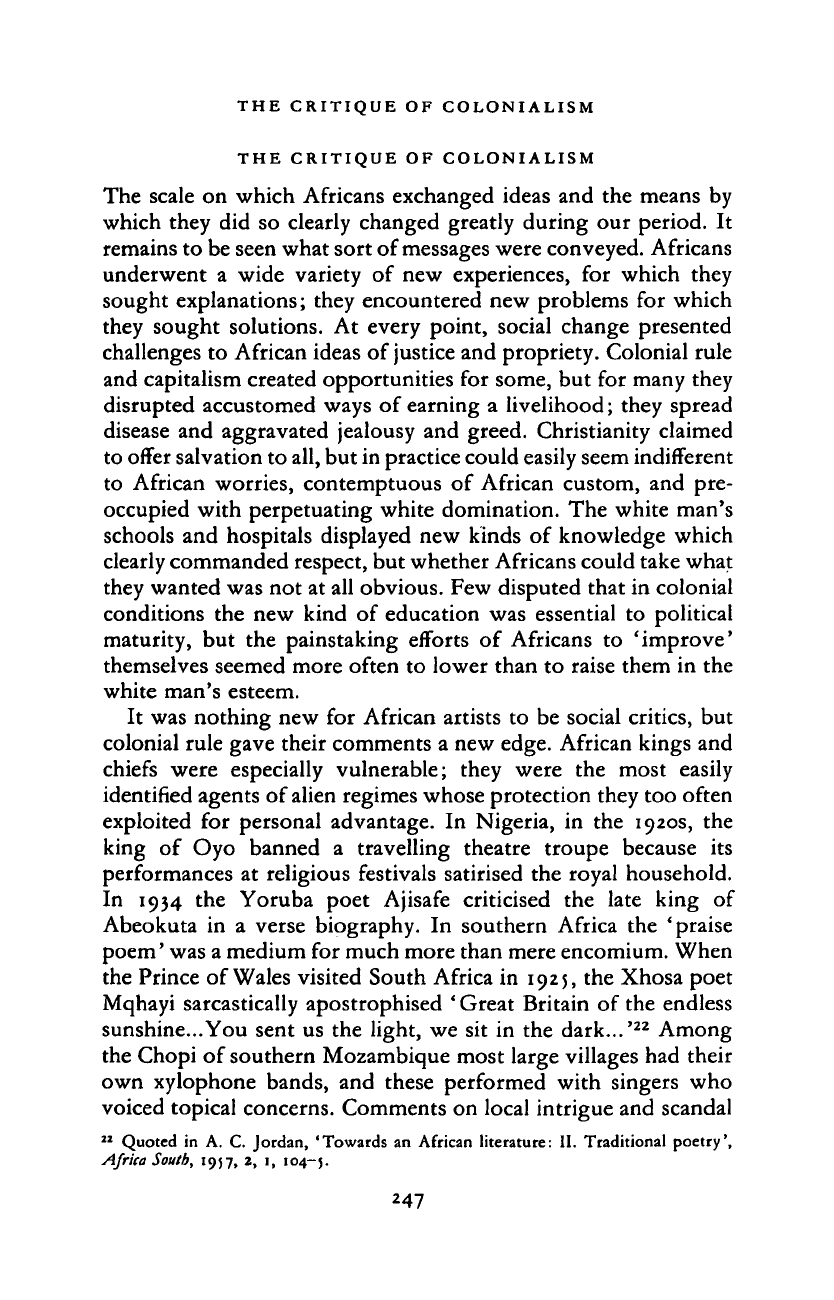
THE CRITIQUE OF COLONIALISM
THE CRITIQUE OF COLONIALISM
The scale on which Africans exchanged ideas and the means by
which they did so clearly changed greatly during our period. It
remains to be seen what sort of messages were conveyed. Africans
underwent a wide variety of new experiences, for which they
sought explanations; they encountered new problems for which
they sought solutions. At every point, social change presented
challenges to African ideas of justice and propriety. Colonial rule
and capitalism created opportunities for some, but for many they
disrupted accustomed ways of earning a livelihood; they spread
disease and aggravated jealousy and greed. Christianity claimed
to offer salvation to
all,
but in practice could easily seem indifferent
to African worries, contemptuous of African custom, and pre-
occupied with perpetuating white domination. The white man's
schools and hospitals displayed new kinds of knowledge which
clearly commanded respect, but whether Africans could take what
they wanted was not at all obvious. Few disputed that in colonial
conditions the new kind of education was essential to political
maturity, but the painstaking efforts of Africans to 'improve'
themselves seemed more often to lower than to raise them in the
white man's esteem.
It was nothing new for African artists to be social critics, but
colonial rule gave their comments a new edge. African kings and
chiefs were especially vulnerable; they were the most easily
identified agents of alien regimes whose protection they too often
exploited for personal advantage. In Nigeria, in the 1920s, the
king of Oyo banned a travelling theatre troupe because its
performances at religious festivals satirised the royal household.
In 1934 the Yoruba poet Ajisafe criticised the late king of
Abeokuta in a verse biography. In southern Africa the 'praise
poem' was a medium for much more than mere encomium. When
the Prince of Wales visited South Africa in 1925, the Xhosa poet
Mqhayi sarcastically apostrophised ' Great Britain of the endless
sunshine...You sent us the light, we sit in the dark...'
22
Among
the Chopi of southern Mozambique most large villages had their
own xylophone bands, and these performed with singers who
voiced topical concerns. Comments on local intrigue and scandal
22
Quoted in A. C. Jordan, 'Towards an African literature: II. Traditional poetry',
Africa South, 1957, 2, i, 104-5.
2
47
Cambridge Histories Online © Cambridge University Press, 2008
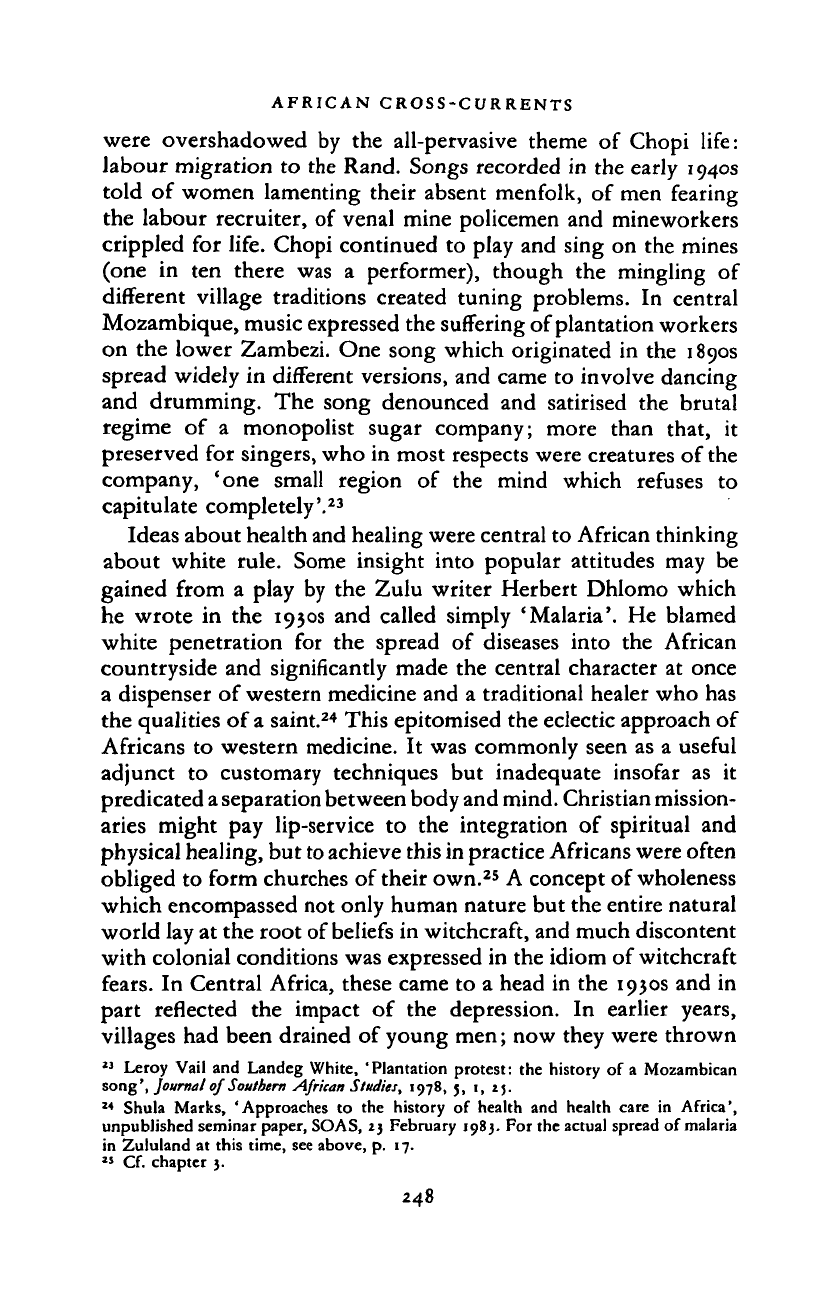
AFRICAN CROSS-CURRENTS
were overshadowed by the all-pervasive theme of Chopi life:
labour migration to the Rand. Songs recorded in the early 1940s
told of women lamenting their absent menfolk, of men fearing
the labour recruiter, of venal mine policemen and mineworkers
crippled for life. Chopi continued to play and sing on the mines
(one in ten there was a performer), though the mingling of
different village traditions created tuning problems. In central
Mozambique, music expressed the suffering of plantation workers
on the lower Zambezi. One song which originated in the 1890s
spread widely in different versions, and came to involve dancing
and drumming. The song denounced and satirised the brutal
regime of a monopolist sugar company; more than that, it
preserved for singers, who in most respects were creatures of the
company, 'one small region of the mind which refuses to
capitulate completely'.
23
Ideas about health and healing were central to African thinking
about white rule. Some insight into popular attitudes may be
gained from a play by the Zulu writer Herbert Dhlomo which
he wrote in the 1930s and called simply 'Malaria'. He blamed
white penetration for the spread of diseases into the African
countryside and significantly made the central character at once
a dispenser of western medicine and a traditional healer who has
the qualities of
a
saint.
24
This epitomised the eclectic approach of
Africans to western medicine. It was commonly seen as a useful
adjunct to customary techniques but inadequate insofar as it
predicated
a
separation between body and mind. Christian mission-
aries might pay lip-service to the integration of spiritual and
physical healing, but
to
achieve this in practice Africans were often
obliged to form churches of their own.
25
A concept of wholeness
which encompassed not only human nature but the entire natural
world lay at the root of beliefs in witchcraft, and much discontent
with colonial conditions was expressed in the idiom of witchcraft
fears.
In Central Africa, these came to a head in the 1930s and in
part reflected the impact of the depression. In earlier years,
villages had been drained of young men; now they were thrown
" Leroy Vail and Landeg White, 'Plantation protest: the history of a Mozambican
song', journal of Southern African Studies, 1978,
5, 1,
25.
24
Shula Marks, 'Approaches to the history of health and health care in Africa',
unpublished seminar paper, SOAS, 23 February 1983. For the actual spread of malaria
in Zululand at this time, see above, p. 17.
15
Cf. chapter 3.
248
Cambridge Histories Online © Cambridge University Press, 2008
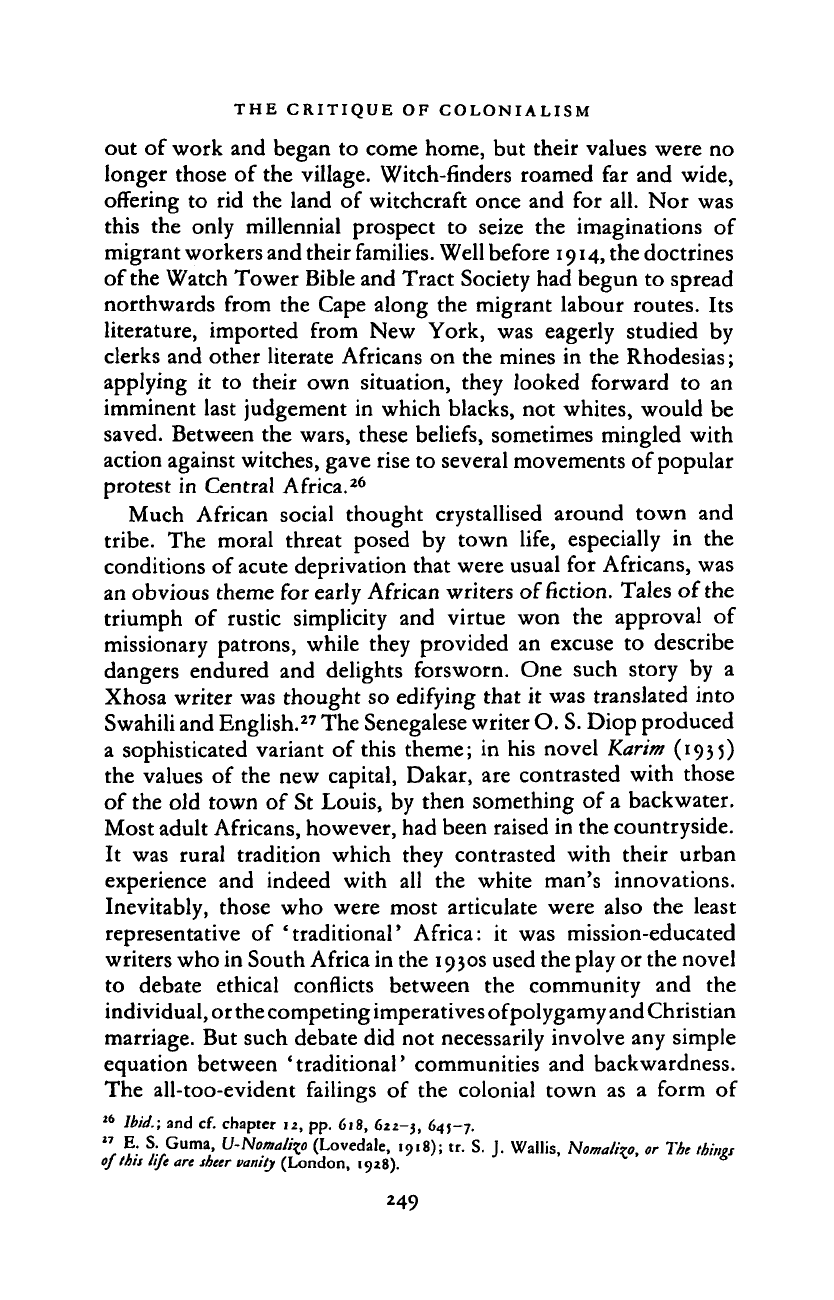
THE CRITIQUE OF COLONIALISM
out of work and began
to
come home, but their values were no
longer those
of
the village. Witch-finders roamed
far
and wide,
offering
to rid
the land
of
witchcraft once and
for
all. Nor was
this
the
only millennial prospect
to
seize
the
imaginations
of
migrant workers and their families. Well before
1914,
the doctrines
of the Watch Tower Bible and Tract Society had begun to spread
northwards from the Cape along the migrant labour routes.
Its
literature, imported from New York, was eagerly studied
by
clerks and other literate Africans on the mines
in
the Rhodesias;
applying
it to
their own situation, they looked forward
to an
imminent last judgement
in
which blacks, not whites, would be
saved. Between the wars, these beliefs, sometimes mingled with
action against witches, gave rise to several movements of popular
protest in Central Africa.
26
Much African social thought crystallised around town
and
tribe.
The
moral threat posed
by
town life, especially
in the
conditions of acute deprivation that were usual for Africans, was
an obvious theme for early African writers
of
fiction. Tales of the
triumph
of
rustic simplicity
and
virtue won
the
approval
of
missionary patrons, while they provided
an
excuse
to
describe
dangers endured
and
delights forsworn. One such story
by a
Xhosa writer was thought so edifying that
it
was translated into
Swahili and English." The Senegalese writer O. S. Diop produced
a sophisticated variant
of
this theme;
in
his novel Karim (1935)
the values
of
the new capital, Dakar, are contrasted with those
of the old town
of
St Louis, by then something of a backwater.
Most adult Africans, however, had been raised in the countryside.
It was rural tradition which they contrasted with their urban
experience
and
indeed with
all the
white man's innovations.
Inevitably, those who were most articulate were also
the
least
representative
of
'traditional' Africa:
it
was mission-educated
writers who in South Africa in the 1930s used the play or the novel
to debate ethical conflicts between
the
community
and the
individual, or the competing imperatives of polygamy and Christian
marriage. But such debate did not necessarily involve any simple
equation between 'traditional' communities and backwardness.
The all-too-evident failings
of
the colonial town
as a
form
of
26
Ibid.;
and
cf.
chapter 12, pp. 618,
622-3,
645-7.
"
E.
S. Guma,
U-Noma/i
Z
o
(Lovedale, 1918); tr. S.
J.
Wallis, Nomalfro, or The thints
of this life are sheer vanity (London, 1928).
249
Cambridge Histories Online © Cambridge University Press, 2008
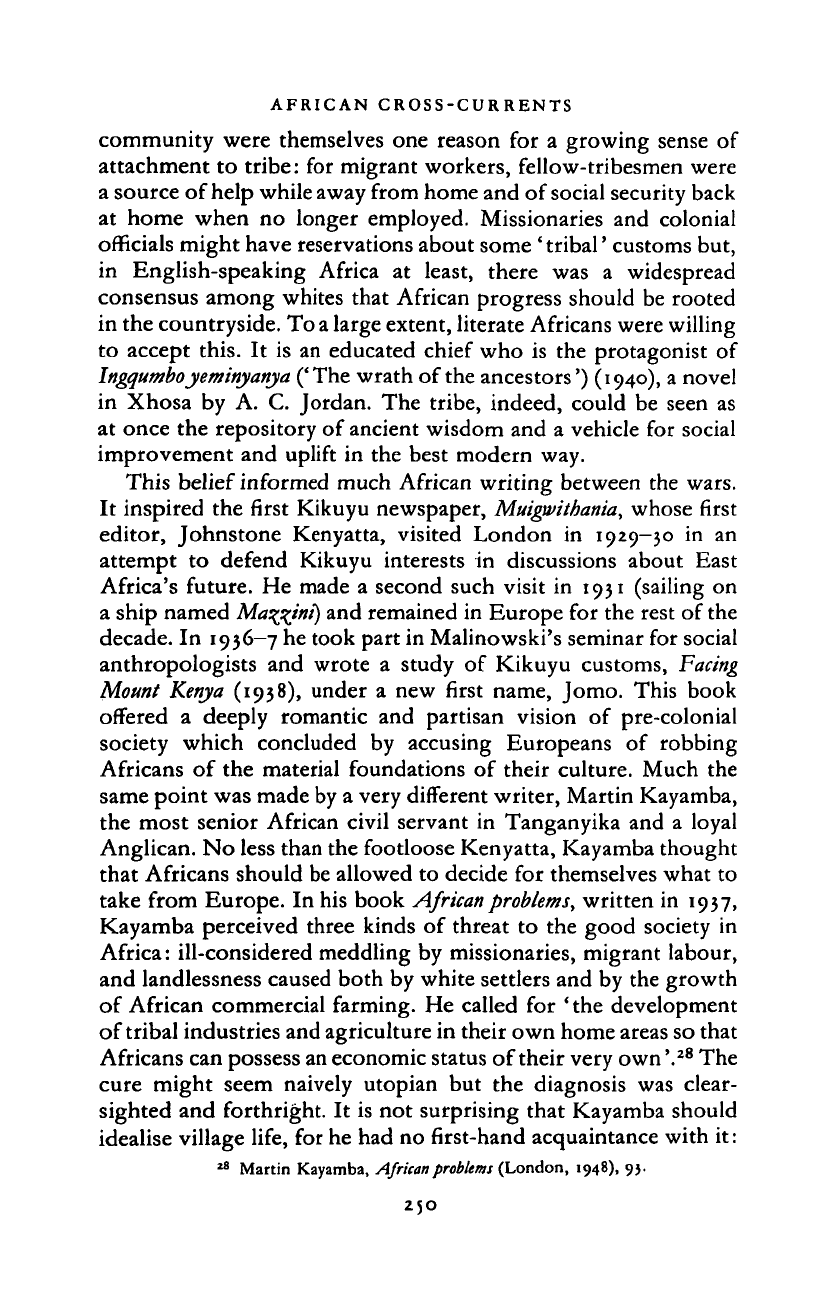
AFRICAN CROSS-CURRENTS
community were themselves one reason for a growing sense of
attachment to tribe: for migrant workers, fellow-tribesmen were
a source of help while away from home and of social security back
at home when no longer employed. Missionaries and colonial
officials might have reservations about some ' tribal' customs but,
in English-speaking Africa at least, there was a widespread
consensus among whites that African progress should be rooted
in the countryside. To
a
large extent, literate Africans were willing
to accept this. It is an educated chief who is the protagonist of
Ingqumbo
yeminyanya
('The wrath of the ancestors') (1940), a novel
in Xhosa by A. C. Jordan. The tribe, indeed, could be seen as
at once the repository of ancient wisdom and a vehicle for social
improvement and uplift in the best modern way.
This belief informed much African writing between the wars.
It inspired the first Kikuyu newspaper,
Muigwithania,
whose first
editor, Johnstone Kenyatta, visited London in 1929-30 in an
attempt to defend Kikuyu interests in discussions about East
Africa's future. He made a second such visit in 1931 (sailing on
a ship named Ma^int) and remained in Europe for the rest of the
decade. In
1936—7
he took part in Malinowski's seminar for social
anthropologists and wrote a study of Kikuyu customs,
Facing
Mount
Kenya
(1938), under a new first name, Jomo. This book
offered a deeply romantic and partisan vision of pre-colonial
society which concluded by accusing Europeans of robbing
Africans of the material foundations of their culture. Much the
same point was made by a very different writer, Martin Kayamba,
the most senior African civil servant in Tanganyika and a loyal
Anglican. No less than the footloose Kenyatta, Kayamba thought
that Africans should be allowed to decide for themselves what to
take from Europe. In his book African
problems,
written in 1937,
Kayamba perceived three kinds of threat to the good society in
Africa: ill-considered meddling by missionaries, migrant labour,
and landlessness caused both by white settlers and by the growth
of African commercial farming. He called for ' the development
of tribal industries and agriculture in their own home areas so that
Africans can possess an economic status of their very own \
28
The
cure might seem naively Utopian but the diagnosis was clear-
sighted and forthright. It is not surprising that Kayamba should
idealise village life, for he had no first-hand acquaintance with it:
28
Martin Kayamba, African problems (London, 1948), 93.
250
Cambridge Histories Online © Cambridge University Press, 2008
